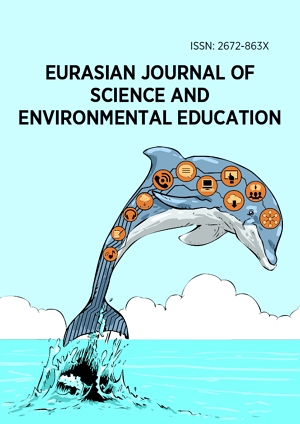Research Article
Physics students’ conceptual understanding of "gravity and free fall”
More Detail
1 Bolgatanga Girls Senior High School, Bolgatanga, GHANA2 University of Education, Winneba, GHANA3 Mfantsipim School, Cape Coast, GHANA* Corresponding Author
Eurasian Journal of Science and Environmental Education, 3(2), December 2023, 61-65, https://doi.org/10.30935/ejsee/13444
Submitted: 20 March 2023, Published Online: 23 June 2023, Published: 01 July 2023
OPEN ACCESS 2786 Views 3468 Downloads
ABSTRACT
The focus of this study is to ascertain the conceptual understanding students of Bolgatanga Girls Senior High School (BGSHS) have in “gravity and free fall”. Descriptive research design (cross-sectional survey) was used in this study as a method of collecting information. Out of 183 second and third year students, 43 of them were randomly selected and involved in the study. Students were given 10 conceptual based test items relating to “gravity and free fall” to respond to. Students were required to respond true/false and provide reasons for their response. It was found that majority of the students had the misconception that gravity is selective and therefore acts more on heavier objects compared to lighter objects. As a result, they are of the opinion that larger object should hit the ground first before a light object dropped from the same height, which is not scientifically accurate. Based on the findings of the study, it was recommended that physics teachers in BGSHS should carefully pay attention to students’ misconceptions and be guided by it when teaching.
CITATION (APA)
Dognia, R., & Dah, M. (2023). Physics students’ conceptual understanding of "gravity and free fall”. Eurasian Journal of Science and Environmental Education, 3(2), 61-65. https://doi.org/10.30935/ejsee/13444
REFERENCES
- American Association of Physics Teachers. (2009). The role, education, qualifications, and professional development of secondary school physics teachers. American Association of Physics Teachers. https://www.aapt.org/resources/upload/secondary-school-physics-teacher-role_booklet.pdf
- Anni, M. (2021). Quantitative comparison between the smartphone based experiments for the gravity acceleration measurement at home. Education Sciences, 11(9), 493. https://doi.org/10.3390/educsci11090493
- APS Advancing Physics (n. d.). Falling physics: Teacher’s guide. American Physical Society. https://www.aps.org/programs/outreach/physicsquest/past/falling-physics.cfm
- Eryilmaz, A. (2002). Effects of conceptual assignments and conceptual change discussions on students’ misconceptions and achievement regarding force and motion. Journal of Research in Science Teaching, 39(10), 1001-1015. https://doi.org/10.1002/tea.10054
- Halim, L., Yong, T. K., & Meerah, T. S. M. (2014). Overcoming students’ misconceptions on forces in equilibrium: An action research study. Creative Education, 5(11), 1032-1042. https://doi.org/10.4236/ce.2014.511117
- Institute of Physics. (2021). Challenging common misconceptions when teaching physics. https://spark.iop.org/misconceptions-blogs
- Keith, M. (2016). Introduction to high school physics. Oxford University Press.
- Kittiravechote, A., & Sujarittham, T. (2020). Measuring the acceleration of gravity using a smartphone, A4-papers, and a pencil. International Journal of Advanced Science and Technology, 29(7), 884-889.
- Kotluk, N., & Kocakaya, S. (2016). Researching and evaluating digital storytelling as a distance education tool in physics instruction: An application with pre-service physics teachers. Turkish Online Journal of Distance Education, 17(1), 87-99. https://doi.org/10.17718/tojde.59900
- Kuczmann, I. (2017). The structure of knowledge and students’ misconceptions in physics. AIP Conference Proceedings, 1916, 050001. https://doi.org/10.1063/1.5017454
- Kurniawan, Y. (2018). Investigation of the misconception in newton II law. Journal Pena Sains, 5(1), 12-18. https://doi.org/10.21107/jps.v5i1.3879
- Munene, K. S. (2014). Factors affecting enrolment and performance in physics among secondary school students in Gatundu District, Kenya [Unpublished master’s thesis]. Kenyatta University.
- Murphy, P. K., & Alexander, P. A. (2013). Situating text, talk, and transfer in conceptual change. In S. Vosniadou (Ed.), International handbook of research on conceptual change. Routledge.
- Pablico, J. R. (2010). Misconceptions on force and gravity among high school students [Master’s thesis, Louisiana State University].
- Santyasa, W., Warpala, W. S., & Tegeh, M. (2018). The effect of conceptual change model in the senior high school students’ understanding and character in learning physics. SHS Web of Conferences, 42, 00058. https://doi.org/10.1051/shsconf/20184200058
- Stein, M., Larrabee T. G., & Barman, C. R. (2008). A study of common beliefs and misconceptions in physical science. Journal of Elementary Science Education, 20(2), 1-11. https://doi.org/10.1007/BF03173666
- Üce, M. & Ceyhan, I. (2019). Misconception in chemistry education and practices to eliminate them: Literature analysis. Journal of Education and Training Studies, 7(3), 202-208. https://doi.org/10.11114/jets.v7i3.3990

 The articles published in this journal are licensed under the CC-BY Creative Commons Attribution International License.
The articles published in this journal are licensed under the CC-BY Creative Commons Attribution International License.